Noise pollution plays an important role in life hygiene.
Whether it is about finding sleep, blocking an annoying lawn mower or preparing a baby’s room, outside noise can become a big deal.
When looking at the weak spot in a home, more often than not, windows are under the spotlight. “How to soundproof a window?” might already have crossed your mind. Let’s dive into that right now!
Why is My Window Not Soundproof?
Air Gaps
Sound waves are sneaky. They will engulf in any air gap your window will offer.
Although this should not be a problem for modern buildings, gaps might appear while the window and its seals are ageing. Before undertaking any heavy expense on your window, it is a good idea to first check the presence of air gaps.
The areas where to look for gaps or crevices are :
- Where the window frame and wall meet
- The contact surface of the mobile part with the fix part
- Around any existing seals
Fortunately, there are options available to seal those gaps. You can directly skip to the related section.
Thickness and Density
When it comes to soundproofing, the parameters that play a role in blocking sound is density and thickness. It is easy to imagine that a 6in concrete wall can block more sound than a window.
Although made of an assembly of different components (frame, layers of glass, seals, inert gas), a window remains less thick and less dense than a wall.
To help us assess the efficiency in blocking sound, the acoustic industry defined the Sound Transmission Class (STC) rating. The higher the rating, the better the assembly blocks sound.
Here are some values to give you an overall idea of the acoustic performance of a window.
- Single pane windows : STC 19
- Double pane windows : STC 28
- Soundproof windows : STC 45~50
- Walls (6in thick) : STC 46~51
You might have noticed the gaps in values. And you might wonder how come a soundproof window is so efficient at blocking sounds. The answer lies in the window construction engineered for better soundproofing results.
What is a Soundproofing Window?
Soundproofing windows leverage 3 key elements to improve sound insulation:
Glass thickness
This kind of window has generally at least 2 layers of glass. The principle lies on an asymmetric double glazing (also called double pane windows). While a classic double glazing uses the same thickness, a soundproof window doesn’t.
To understand how it works, imagine a high pitch noise in contact with the first glazing. Doing so, the sound is distorted in a lower pitch noise in the cavity between the 2 glazing. The second glazing is thicker (and thus heavier) than the first glazing. This choice in thickness makes it more effective at blocking low pitch noise.
Type of Glass
The type of glass. In windows manufacturing, the choice of glass goes down to tempered or laminated. Soundproof windows use laminated glasses. A laminated glass includes an interlayer of plastic preventing it from shattering when broken. The interlayer has sound absorption properties, thus relevant for sound insulation purposes. Interlayers are either made of :
- Polyvinyl butyral (PVB)
- Ethylene-vinyl acetate (EVA)
- Or Thermoplastic Polyurethane (TPU)
Gas
The gas and space between the two glazing. A sound doesn’t spread the same way in the air or in the water. By using specific gases, it makes sound waves harder to transit through. Thus, enhancing the sound insulation properties. Manufacturers turn to inert gases like Argon or Krypton for that purpose.
To illustrate this, we can compare the speed of sound in the air, argon and krypton. A higher speed means sound propagates more easily.
- Speed of sound in krypton: 221m/s
- Speed of sound in argon: 319m/s
- Speed of sound in air: 341m/s
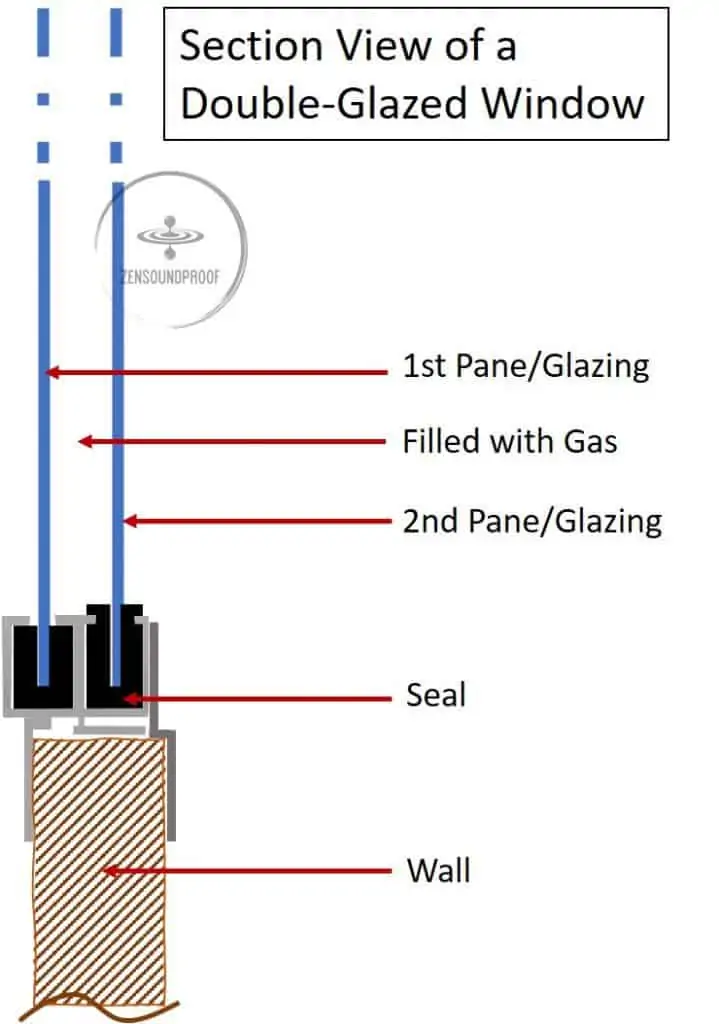
Distance between panes
Playing with the space between the two panes is another parameter for sound insulation. The wider the gap the higher the STC performance of the window.
The next section guides you through the most common tips for improving window acoustic performance.
Methods How to Soundproof a Window
1. Upgrade to Soundproof Windows
If you happen to have a single pane window installed, upgrading to a soundproof window can be an option. This is not the cheapest solution but it is a clean one. You get what you pay for and in the end you might be happy to invest in your home sweet home.
You’ll need to call a professional for the installation. These types of windows don’t come for cheap. Depending on the quality, you can count between 400 $ to 1000 $ for a double pane window. While choosing your frame and your model, make sure to ask your provider the STC ratings. Make sure the rating advertised is in the range of a soundproof window which is around a STC of 45.
The thermal insulation is as effective as a “classic” double pane window. So it should not be a concern.
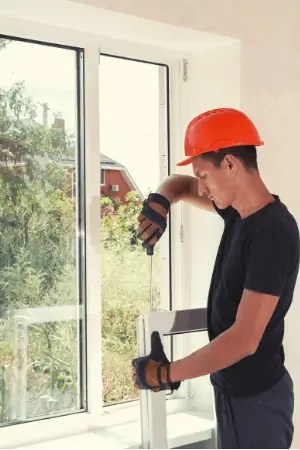
2. Install Noise Reduction Window Inserts (aka Storm Window)
I like this solution. It’s literally a window for your window. It consists in mounting a window inside or outside of the main window. The storm window can be permanent or temporary installed.
Initially, storm windows were installed on old houses. Their purpose was to protect panes from damages during harsh weather. It also happens that storm windows contribute to thermal and acoustic insulation. For modern construction, they are mainly used for insulation enhancement.
The addition of a window insert will create a pouch of air between your window and the insert. This air volume acts as a trap for sound waves until it’s deadened. According to “Indow Windows” lab tests results, the more the distance the better the soundproofing.
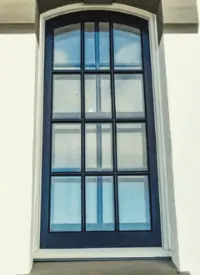
The Main Material
The window insert adds one extra layer of vane. The pane can be either made of:
- Glass. I would recommend going for laminated glass. Per its composition, it makes it the best choice for sound insulation performance.
- Rigid acrylic (plastic) sheet. Standard grade acrylic sheet is ⅛ in. thick. An Acoustic grade sheet is twice thicker (¼ in.). Acrylic is lighter, and less costly to manufacture than glass. This makes it a more cost-efficient solution. However, acrylic tends to turn yellow while ageing.
I would recommend going for an acoustic grade acrylic sheet. Indeed, a window insert with acoustic grade acrylic improves the STC of a dual pane window from 31 up to 45. (According test reports from the manufacturer “Indow Windows”)
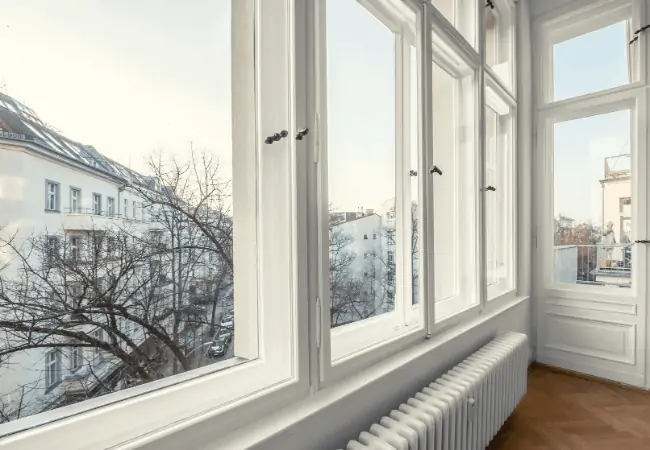
Note: You can consult “Indow Windows” technical reports here. There is a lot of valuable information, such as the comparison of STC between Double-pane, Triple-pane, and soundproof window. (See page 2, figure 1).
This test shows a Triple pane window achieves almost the same STC rating as a soundproof window.
Installation
There are several ways to install a window insert / storm window.
- Magnetic bands are installed on the frame of the window. The window insert is then installed on those magnetic bands.
- Compression gasket.The glass window insert is surrounded by a compression gasket. When installed the gasket is compressed against the frame of the window. The compression maintains the insert in position.
- Screws. The storm window is simply maintained in position with screws.
3. Seal the Gaps Around your Window
All around the window, you should check the presence of crevices or gaps letting air through. To identify air gaps, use the feel of your hand or the smoke of an incense while the room is dark.
To seal the gaps, do not use ordinary caulk. It is better to use acoustic sealant. The main difference is that acoustical sealant is designed to remain flexible.
Ordinary caulk tends to become hard and crack over the course of time. It should not be hard to differentiate them, it is generally described on the packaging.
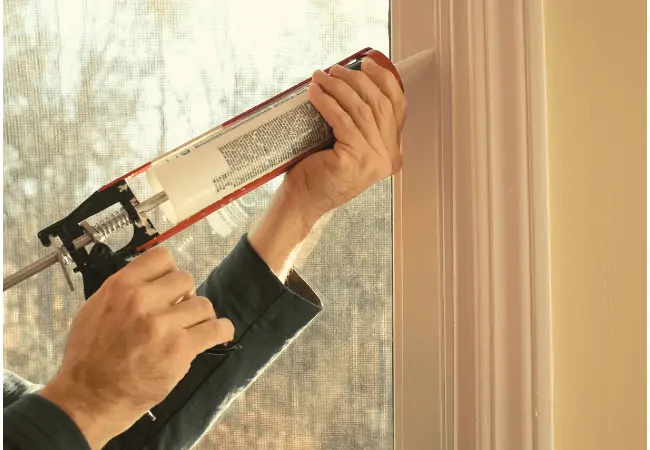
4. Apply Weatherstripping
Weatherstrip is used to seal the gap between movable parts and fixed parts of your window. The purpose of this seal is to protect water to come in or heat to escape through the window.
- First you’ll need to identify where you want to apply your weatherstrip. It can be on the side sash of the window or between the sash and the frame.
- Then you can clean the surface of application for the adhesive of the sealstrip to adhere.
- Finally you can apply the seal. A seal that’s well installed is a seal that is compressed when your window is closed.
There are different shapes of weatherstrip. Make sure you pick the right width and thickness for your application.
5. Install a Sound Blanket
A sound blanket is a material made of a layer of Mass Loaded Vinyl (MLV) sandwiched between quilted fiberglass. It comes with grommets so that you can hang in like a curtain over your window. Depending on the model, you can have velcro along the vertical edges to attach it around the window. So that it doesn’t leave space between the blanket and the window, unlike a traditional curtain would.
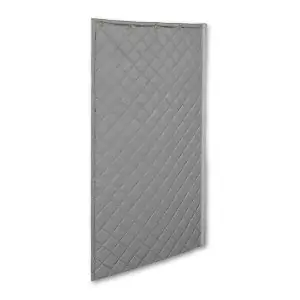

Source: Acoustical Solutions (swipe image to see material construction)
The acoustic performance is good, since it is a piece of heavy and thick material. It provides a good amount of sound blocking and sound absorption to your window.
All that being said, you’ll have to keep in mind, this is not very aesthetic. It is more or less developed for industrial use such as acoustic labs. For a personal use at home, bear in mind it will block access to light. However it can be retracted like a curtain (Although not as pretty as a curtain). This solution is good if you need a quick one.
If you’re interested in the sound insulation technical data, you can check it out on this model here. The company Acoustical Solutions proposes a product with similar acoustic performance. Acoustical Solutions also displays a heavier version (twice more dense). If you’re looking to counter low frequency sounds, the heavier version will be more effective.
A panel like this should cost you between 300$ and 900$ depending on the size. It is costly but it is easy to install and polyvalent. It can also be used for doors.
6. Install a Soundproof Curtain
If you don’t want to make a big investment and keep your window functional, you can install curtains. It is a versatile option.
On one hand you can still access light and open your window.
On another hand, the fabric’s thickness will:
- Absorb some sound from outside
- And improve the acoustic in your room (by reducing the sound reverberation inside)
However, I can guarantee you a curtain will not block sounds in your room. No matter the thickness or the quality of your fabric. Learn more about soundproof curtains here.
Two tricks that can optimize a curtain’s noise reduction performance:
- You can install a velcro band around your window. The velcro will maintain the curtain close to the window and leave little space for air gaps. Remember, sound is sneaky and will choose the easiest option to get into your room.
- Pick thick and heavy curtains. On the market, I would recommend picking curtains advertised for soundproofing. Then I would recommend checking if the fabric uses triple weave technology. Lastly, I advise you to go for a curtain with multiple layers of fabric. Some curtains even integrate felt lining which is effective for mitigating sound intensity.
7. Install a Noise Blocking Film
A noise blocking film is used for heat insulation enhancement in homes. Contrary to beliefs, the film is not directly stuck on the pane of the window but on the frame.
The idea is to reproduce the same pattern as a double glazing window with air trapped by the film.
But the film is thin and quite light. So why is it helping in soundproofing ?
- It seals your window by stopping air coming through. In this sense, the film does the job of an acoustic caulk, sealing air gaps.
- Air is “trapped” between your original pane and the film. It generates an effect that’s similar to a double pane window.
It is very cheap. It would cost around 20$ for a kit to seal 4 windows.
It’s also easy to install: simply use double tape to stick in on your window frame. Moreover, depending on the window configuration and where the film is installed, you might not open the window anymore.
The noise blocking film is very fragile: it is easy to tear. Moreover, it is not very aesthetic but still discrete. Thus, I wouldn’t recommend it for a long term solution to soundproof your window. However, if you’re renting a place and don’t want to spend much, it might be the perfect solution.
8. Make & Use a DIY Window Plug
A window plug is literally a plug on your window. You can say farewell to sunlight and the fresh air. But if you don’t have the utility for a window and the outside noise is unbearable, that solution is for you.
Make your DIY window plug. It is a fun project to undertake and easy to do.
- Step 1:
Choose a dense material like an OSB or MDF as your main panel. Cut it to the dimensions of your window sill. Keep in mind, it has to fit in like a plug and the weight should be acceptable for one person to carry. - Step 2:
Choose an acoustic foam. It can be foam used for car soundproofing (easy to procure and versatile to cut in desired dimensions). Or it can be acoustic panels.
You can stick the foam on the panel (from step 1) so that it covers the maximum of its surface. In terms of thickness, the foam should not be compressed against the window. The ideal is to leave space in order to trap air between the panel and the window. - Step 3:
Install handles. The handles are primordial for your window plug to be convenient. You can make handles with simple wood protrusion drilled in the main support. Or you can use fabric straps.
This DIY project will cost your less than 50$
Summary
I won’t go on the way of telling you to remove the window or put furniture in front of the window. You already know what’s best for your home.
My main advice on how to approach window soundproofing is:
First try simple and cheap solutions like:
- Sealing air gaps
- Weatherstripping
- Or installing a noise blocking film
It will help you understand if it provides enough of an improvement.
If it doesn’t, then you can progress to more expensive solutions like the curtains.
Finally, if anything said before is not effective enough, you can start to look to invest for window inserts, or for an upgrade of windows.
Remember, it is important to take time to investigate what will be effective in your case before spending tons of money.
Peace & Zen-up

2 thoughts on “How to Soundproof a Window? 8 Easy Tips”
Thanks for the tips ! 🙂
Thanks for the useful tips, as someone who plays guitar, I’d need this.